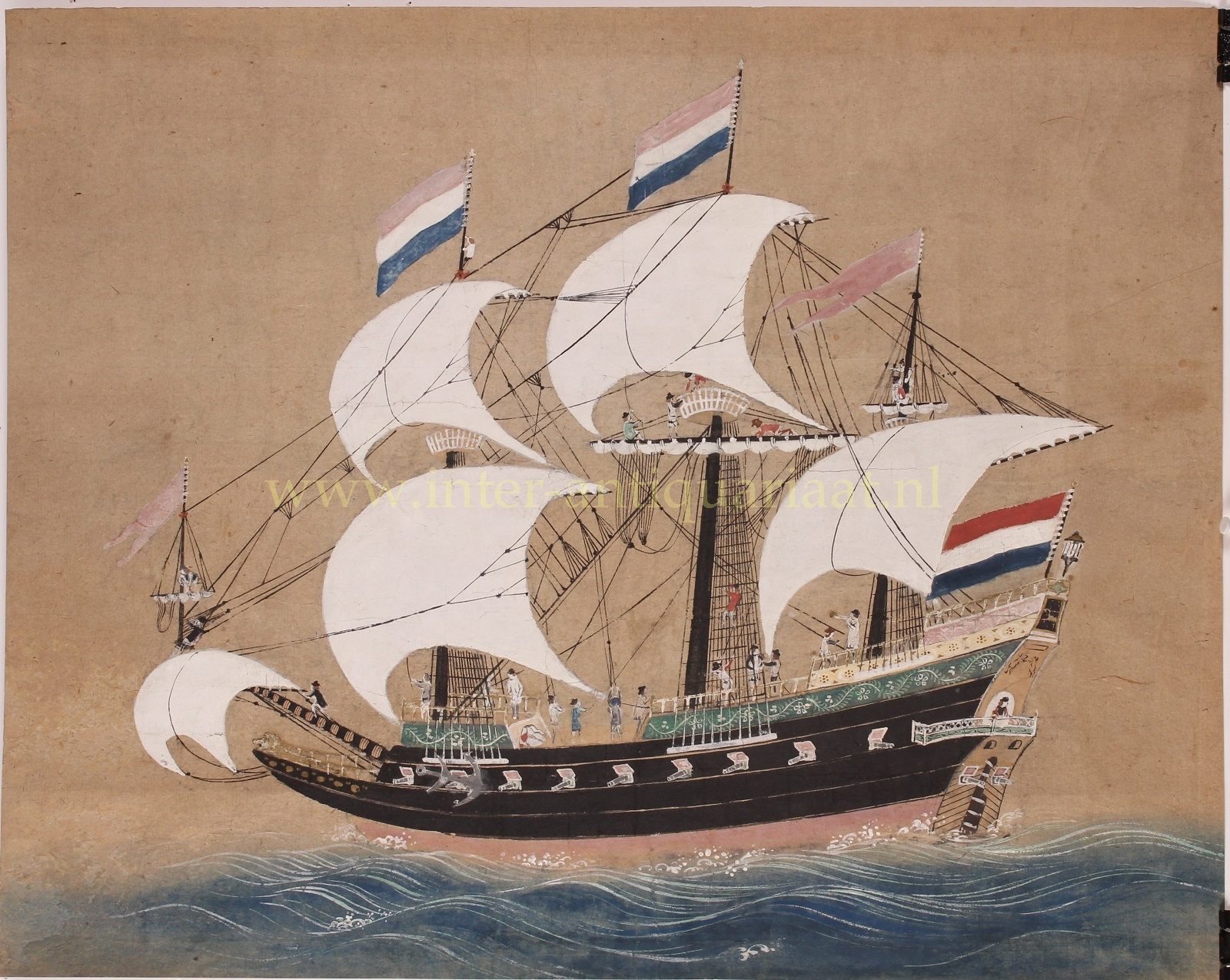Ship of the Dutch East India Company, drawing in gouache made by an anonymous artist around 1760. Size (paper): 42 x 53 cm.
From the 1630s to the mid-1800s, Japan was virtually closed to foreigners. From 1641 onwards, the Dutch were the only Westerners allowed to stay and trade there. They had to adhere to strict regulations and were only allowed to live on Dejima, an artificial island in the port of Nagasaki.
The ships themselves, with their richly decorated sterns and colourful flags, were an attraction for the Japanese. Impressive was the speed with which the sails could be raised and lowered, and the heavy cannons that enveloped the ships in clouds of smoke when a salute was fired.
The Japanese fulfilled a need when made prints and drawings of the Dutch and their ships. Japanese people were curious about the foreigners in their country and often bought the artworks as souvenirs during their stay in Nagasaki.
Between June and September, when the East Indiamen were anchored in Nagasaki Bay, artists had plenty of opportunities to observe the ships firsthand. Even from fairly close distances, as it was permitted to sail small boats around the ships, allowing them to examine and sketch all the distinctive details of the armed merchant vessels. Furthermore, the Dutch ships were regularly visited by Japanese authorities. The Japanese interpreters present during such visits could obtain first-hand information about the ships and easily pass that information on to the artists.
The ships were typically equipped with three masts and a bowsprit. The mainmast in the center of the ship and the foremast at the bow were square-rigged, while the mizzenmast on the upper quarterdeck was rigged fore-and-aft. The bowsprit could be fitted with two additional sails. Ships intended for trade with Asia were double-hulled, and the hull was constructed with multiple layers of wood.
The Dutch East Indiaman in this gouache painting has a fantasized rigging, with technically many inaccuracies. The stern of the ship is also much too narrow. The decorative floral border on the superstructure is, of course, whimsical and the entire crew appears to be wearing officer’s hats. It’s interesting to note that someone on the aft deck seems to be using a telescope, a Dutch invention that commanded respect in 17th-century Japan and is on many depictions of Dutch ships.
In 1695 Nishikawa Joken, the Nagasaki scholar describing the people’s of the world, wrote about “Red-Hair ships: The average length of the these ships is 25-26 ken (45,5-47,3 m), whilst the smaller ones are only about 20 ken (36,4 m). Their depth is 7 or 8 ken (12,7 or 14,6 m). They mount 22, 23, 24 or 25 guns as a rule, each measuring 8 or 9 shaku (240 or 270 cm). There are four masts (including the bowsprit), each of which is made in two pieces, being joined at a circular top. These masts can be lengthened or shortened when and if required, whilst each mast is provided with two sails, all made of sail-cloth. Formerly ships measuring 33 ken (60m) in length sometimes came. The rudder is affixed to the stern. The anchors are all made of iron, some of them being as long as 3 or 4 ken (5,5 or 7,3m). The ropes are made of hemp, measuring 1 shaku, 2 or 3 sun (36 or 39 cm) in circumference. The black coat of the hull is coated with pitch. The red-rust coloured part of the ship below the water-line is everywhere covered with small iron nails. These ships never required repairs during their lifetime. Their ship’s gear, rope, tackle etc. are all coated with pitch; pitch is a substance composed of pine resin mixed with oil.
In 1858 the Dutch monopoly ended and the Dejima era was over. The United States, Great Britain, France, and Russia also gained trade rights with Japan. The foreigners settled in Yokohama, which quickly developed into Japan’s convenient port. They had much more freedom of movement there than in Nagasaki. Women were now also allowed to stay there. An international community developed, in which the Dutch were no longer the most important.
Price: SOLD


